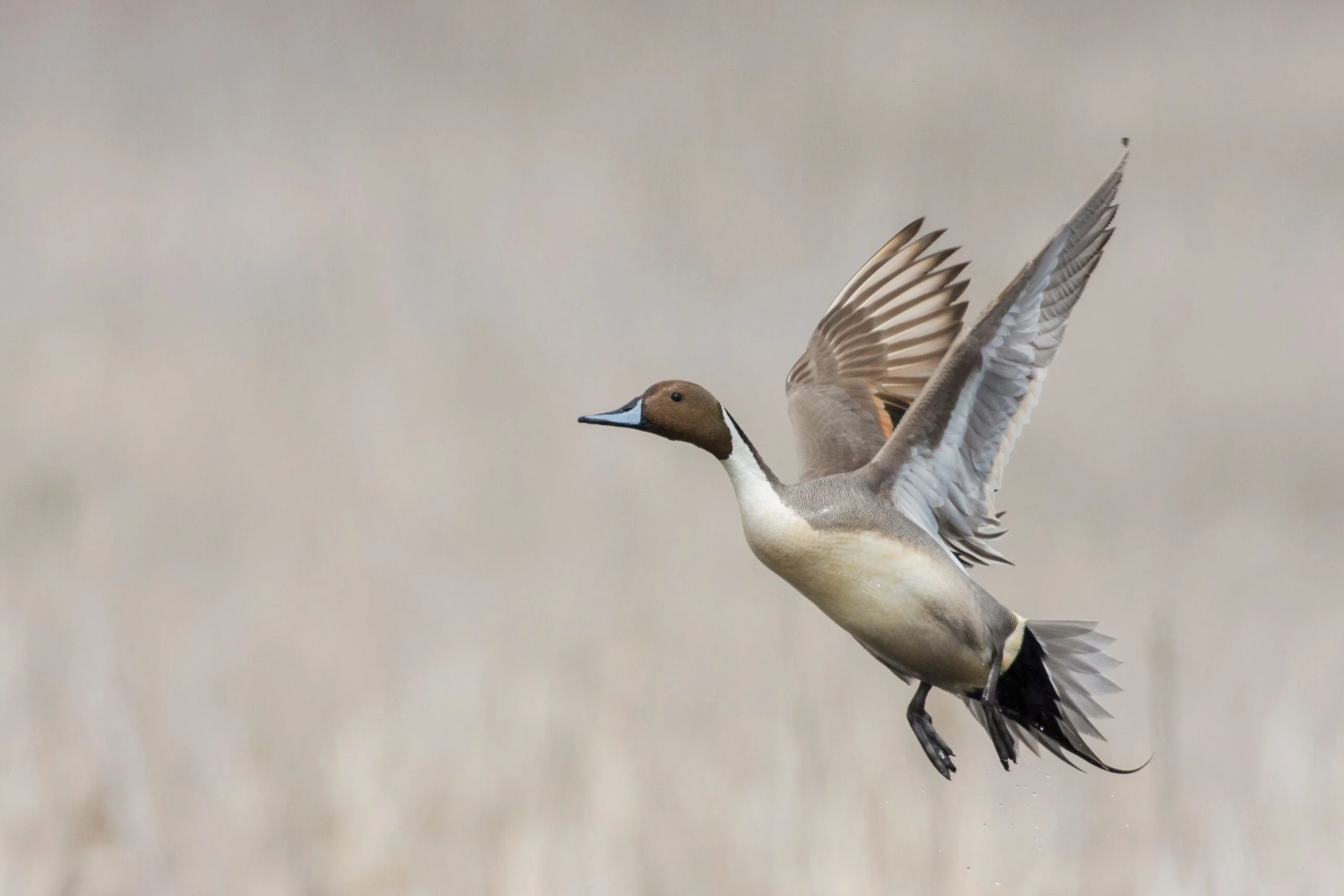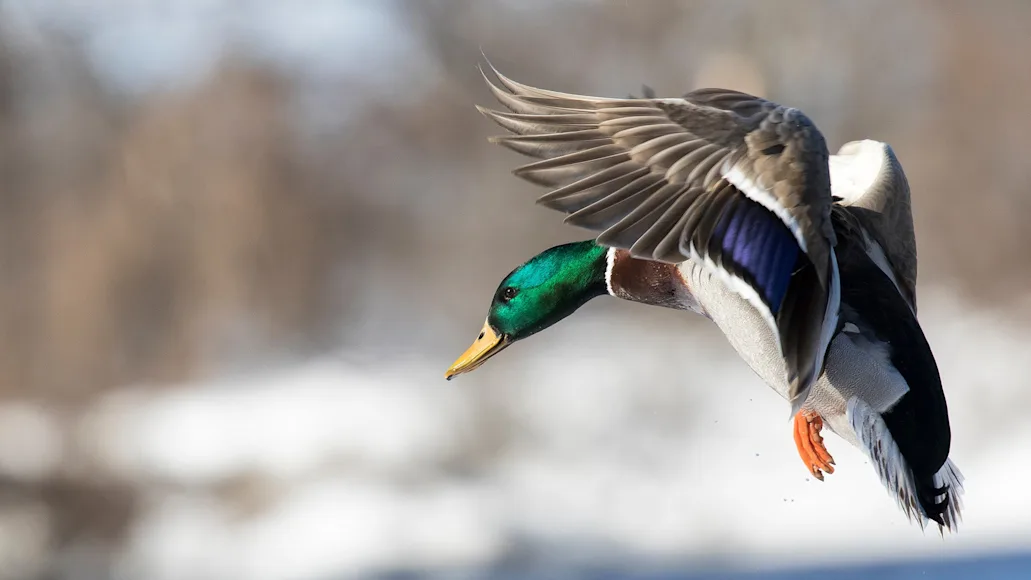I grew up in northeast Ohio in the 1970s, which meant, as a duck hunter
, I grew up hearing duck sounds from mallards and black ducks, both of which quack. My father and I didn’t attempt to call wood ducks, for as he often said, “they’re either coming here or they’re not.” Teal? Same story; no calling. Divers? Never hunted them because, and to quote my old man again, “they taste bad and they’re not mallards or black ducks.”
Then in 1993, I moved to Washington State and introduced my soon-to-be wife, Julia, to duck hunting. I quickly learned, though, that Washington had more to offer in terms of waterfowl species than did Ohio. It quickly felt like I’d moved to a foreign country, as the birds seemingly spoke another language. And, it soon became apparent that if I were to become proficient in calling these new ducks, I’d have to learn a new way. Truthfully, speaking these second languages isn’t difficult, if you know what you’re talking to, what you’re saying
, and you arm yourself with the right instrument.
Mallards
The Call – Bill Saunders’ The Clutch
It’s common knowledge, I believe, that mallard ducks “QUACK.” Surprising, perhaps, to some, mallards make a lot of different sounds as well, including the drake’s lispy “DWEEK,” squeals, whines, whistles, chuckles, and short nasally barks. However, it’s the quack that waterfowlers should learn, practice, and apply in the field.
So, is it necessary for a duck hunter to know 10 different mallard sounds, or is the basic quack enough to convince most greenheads?
“When it comes right down to it, a five- to seven-note ‘QUACK…QUACK…quack-quack-quack‘ is all you really need to do to kill ducks,” Saunders said. “A lot of times, I feel like feed calls, single quacks, ‘bouncing hens,’ and different things like that are maybe more for show. I’ve killed thousands of mallards, and I’ve never once thought, ‘Oh my gosh! I feed chuckled those things right to the ground.’ It’s a five- to seven-note greeting type of call.”
Situationally, Saunders went on to say callers may drag those five notes out a bit to get the birds to turn, or speed the cadence up.
Duck Sounds: Widgeon
The Call – Slayer Calls’ Whistler’s Mother
Widgeon are a vocal bird, both in the air and on the water, and it’s easy to imitate their simple two- or three-note whistling call. For years, I used an ordinary dog whistle upside-down to keep the pea inside from rattling and producing the trill. Others, including my wife, use their natural voice. Still others opt for a more conventional widgeon whistle. Slayer Calls makes an excellent and quite elemental whistle, which, in addition to creating widgeon sounds, can also be used to reproduce the calls of a drake mallard, green-wing teal, drake pintail, wood duck, and, for you turkey hunters, the scream of a red-tailed hawk.
Phonetically, the widgeon’s call sounds like “woo, whIT, woo,” with each note being produced in a breathy sort of way. The drake also makes a two-note whistle—“whIT, woo.” Because widgeon are so vocal and often travel in larger groups, I’ve found it advantageous to have as many callers as possible blowing whistles.
Duck Sounds: Pintails

Unlike the widgeon’s breathy tones, the bull sprig’s whistle is bell-like in its clarity, and does incorporate a rolling trill. Adobe Stock / Danita Delimont
The Call – Haydel’s MP-90 Magnum Pintail
Unlike the widgeon’s breathy tones, the bull sprig’s whistle is bell-like in its clarity, and does incorporate a rolling trill. Here, a dog whistle will work, sometimes quite well. However, I’ve found that the sprig-specific calls like Rod Haydel’s MP-90 produce a clearer, truer tone.
“There are only so many sounds that pintails make,” Haydel said. “The hen does sound similar to a hen mallard, only much softer and more monotone. She’ll usually make three or four low-pitch quacks, but again, it’s a monotone sound. The drakes whistle, but you have to roll your tongue to make that sound. It’s very simple and easy to do; you block the exhaust port at the end of the call completely with your finger, and do about a one-second trill by rolling your tongue. The sound comes out of the top of the call.”
Duck Sounds: Gadwall
The Call – Duck Commander’s Gadwall Drake
I’ll never forget the first time I heard a drake gadwall. I’d always heard about the drake grey’s odd nasally “dink…dink-dink…dink…dink” call, but hadn’t heard it personally. It was over a small pond and the best I could tell, the gadwall migration was on that morning, for small flocks of grey ducks kept coming and going throughout the day. This particular bird was a loner, a high-flying drake that locked up without hesitation upon seeing the small spread we’d set just outside the smartweed. To accompany his descent into the decoys, he repeatedly made that now-familiar dink…dink-dink sound. That is, until my father crumpled him right smartly with an ounce and quarter of steel No. 4s.
Instruments designed to reproduce the dink…dink-dink call of the drake grey duck are available, as evidenced by Phil Robertson’s offering. Some men, too, and four-time Tennessee State duck calling champion, Bill Cooksey, being one of them, can mimic the strange sound almost perfectly, using nothing more than their go-to single reed mallard call. The dink…dink-dink can work in other field situations, too, particularly where it’s being used as a confidence call.
Duck Sounds: Wood ducks
The Call – Flextone Wood Duck Call
Growing up with an abundance of wood ducks, it was my experience that 99 percent of the woody population will ignore a wood duck call. However, I did on one occasion see a small flock change course and return to a timbered pothole where a cousin of mine, wood duck call in hand, had just called to them in their “peet – w-o-o-O-O-I-T” rising whistle. Coincidence? Perhaps, but it was enough to convince me that on that one-in-a-million occasion when a flying wood duck wants to listen, he will.
Sometimes the high-pitched “creeeeek creeeeek” in-flight call of the wood duck will get a flock’s attention. Then, when they’re within 100 yards or so, the whine, the aforementioned peep-whistle, or simply the rising whistle portion of the call can convince them to light. Better yet, wait until the birds have landed, entice them closer with the promise of company using the whine, and then practice the oft-forgotten art of jump shooting.
Duck Sounds: Teal
The Call – Primos’ Model 889 Blue-Wing Teal Call
There is a difference between blue- and green-wing teal in terms of calls and calling. The basic call for blue-wings is very similar to the hen mallard’s greeting call—the differences being the pitch, which is much higher, and the cadence, which is much quicker. Many folks, myself included, use a traditional mallard call on blue-wings. More air and tongue pressure increases the pitch, and all that leaves is to step up the cadence or rhythm. Teal-specific calls, however, like Primos’ Model 889, are tuned higher out of the box. They do, however, require more air pressure, and a radical departure from the traditional mallard cadence.
Green-wing teal, on the other hand, are what I’ll call “peepers.” They make a high-pitched whistled “PEEP“—short of duration and high in volume. The rhythm when calling green-wings can be recognized phonetically as, “peep, peep-peep! peep.” Buck Gardner’s 6N1 does a fine job of reproducing these duck sounds, as does Sure Shot’s compact 7-IN-1 Rascal.
Bluebills, Canvasbacks, and Redheads
The Call – Haydel’s DC-14 Diver Call
To make the low-pitched breathy guttural growl, or rising “bbbuuurrrrrr” of the bluebill—Canvasbacks and redheads utter similar sounds while on the water—I use an older Rich ‘n Tone Quackhead J-frame single reed. To make this sound, along with what can best be described as sharp barks, I flutter my tongue while growling into the call. If you’re wanting a diver-specific call, Haydel’s DC-14 is incredibly user-friendly, and features a removable exhaust plug that, when pulled, allows for greater volume. On big water, attracting divers by sound is often exclusively a matter of volume.
Volume is important, but gaining the attention of any duck other than a mallard is simply a matter of speaking their language.






